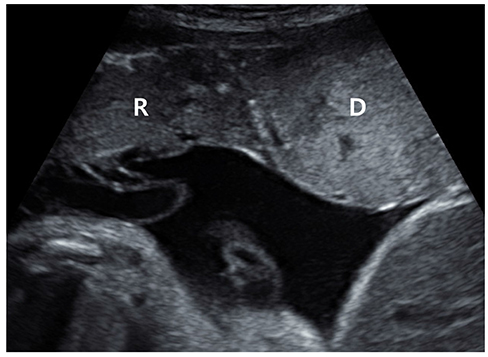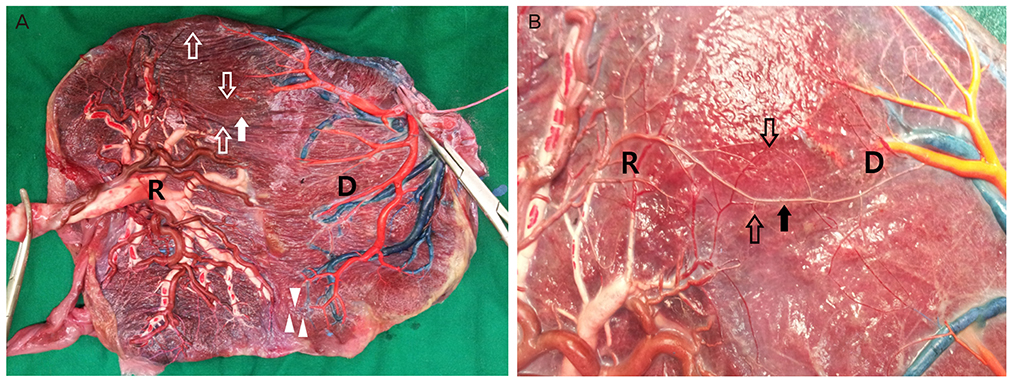Obstet Gynecol Sci.
2016 Nov;59(6):539-543. 10.5468/ogs.2016.59.6.539.
Prenatal diagnosis of spontaneous twin anemia-polycythemia sequence and postnatal examination of placental vascular anastomoses
- Affiliations
-
- 1Department of Obstetrics and Gynecology, Catholic University of Daegu School of Medicine, Daegu, Korea. magu815@cu.ac.kr
- KMID: 2378581
- DOI: http://doi.org/10.5468/ogs.2016.59.6.539
Abstract
- Twin anemia-polycythemia sequence (TAPS) is characterized by a wide discrepancy of hemoglobin between two monochorionic fetuses without sign of twin oligo-polyhydramnios sequence. A primiparous woman with monochorionic diamniotic twin transferred for preterm labor. Ultrasonographic evaluation at 32+3 weeks of gestation revealed increased middle cerebral artery-peak systolic velocity (77.4 cm/sec, 1.69 multiples of median) in donor and decreased in recipient twin (36.4 cm/sec, 0.79 multiples of median), the twin was diagnosed with TAPS. Repeated cesarean section was performed at 32+5 weeks of gestation following preeclampsia and preterm labor. After delivery, TAPS was confirmed through neonatal hematologic examination. There were no signs of acute hemorrhagic shock or brain injury. Placental evaluation via dye infusion and barium angiogram revealed one arterioarterial anastomoses with six arteriovenous anastomoses of placenta. We report a prenatally diagnosed case of spontaneous TAPS with arterioarterial and arteriovenous anastomoses and suggest careful monitoring of monochorionic twin and opinion on placenta vascular architecture.
Keyword
MeSH Terms
Figure
Reference
-
1. Slaghekke F, Kist WJ, Oepkes D, Pasman SA, Middeldorp JM, Klumper FJ, et al. Twin anemia-polycythemia sequence: diagnostic criteria, classification, perinatal management and outcome. Fetal Diagn Ther. 2010; 27:181–190.2. Lopriore E, Middeldorp JM, Oepkes D, Kanhai HH, Walther FJ, Vandenbussche FP. Twin anemia-polycythemia sequence in two monochorionic twin pairs without oligo-polyhydramnios sequence. Placenta. 2007; 28:47–51.3. Lopriore E, Slaghekke F, Oepkes D, Middeldorp JM, Vandenbussche FP, Walther FJ. Hematological characteristics in neonates with twin anemia-polycythemia sequence (TAPS). Prenat Diagn. 2010; 30:251–255.4. Groussolles M, Sartor A, Connan L, Vayssiere C. Evolution of middle cerebral artery peak systolic velocity after a successful laser procedure for iatrogenic twin anemia-polycythemia sequence. Ultrasound Obstet Gynecol. 2012; 39:354–356.5. Herway C, Johnson A, Moise K, Moise KJ Jr. Fetal intraperitoneal transfusion for iatrogenic twin anemia-polycythemia sequence after laser therapy. Ultrasound Obstet Gynecol. 2009; 33:592–594.6. Lopriore E, Slaghekke F, Kersbergen KJ, de Vries LS, Drogtrop AP, Middeldorp JM, et al. Severe cerebral injury in a recipient with twin anemia-polycythemia sequence. Ultrasound Obstet Gynecol. 2013; 41:702–706.7. van Meir H, Slaghekke F, Lopriore E, van Wijngaarden WJ. Arterio-arterial anastomoses do not prevent the development of twin anemia-polycythemia sequence. Placenta. 2010; 31:163–165.8. Suzuki S. Twin anemia-polycythemia sequence with placental arterio-arterial anastomoses. Placenta. 2010; 31:652.9. Movva VC, Rijhsinghani A. Discrepancy in placental echogenicity: a sign of twin anemia polycythemia sequence. Prenat Diagn. 2014; 34:809–811.10. Lopriore E, Slaghekke F, Oepkes D, Middeldorp JM, Vandenbussche FP, Walther FJ. Clinical outcome in neonates with twin anemia-polycythemia sequence. Am J Obstet Gynecol. 2010; 203:54.e1–54.e5.11. Slaghekke F, Favre R, Peeters SH, Middeldorp JM, Weingertner AS, van Zwet EW, et al. Laser surgery as a management option for twin anemia-polycythemia sequence. Ultrasound Obstet Gynecol. 2014; 44:304–310.12. Slaghekke F, van den Wijngaard JP, Akkermans J, van Gemert MJ, Middeldorp JM, Klumper FJ, et al. Intrauterine transfusion combined with partial exchange transfusion for twin anemia polycythemia sequence: modeling a novel technique. Placenta. 2015; 36:599–602.13. Assaf SA, Benirschke K, Chmait RH. Spontaneous twin anemia-polycythemia sequence complicated by recipient placental vascular thrombosis and hydrops fetalis. J Matern Fetal Neonatal Med. 2011; 24:549–552.14. Ishii K, Hayashi S, Mabuchi A, Taguchi T, Yamamoto R, Murata M, et al. Therapy by laser equatorial placental dichorionization for early-onset spontaneous twin anemia-polycythemia sequence. Fetal Diagn Ther. 2014; 35:65–68.
- Full Text Links
- Actions
-
Cited
- CITED
-
- Close
- Share
- Similar articles
-
- A Case of Spontaneous Twin Anemia-Polycythemia Sequence
- Twin anemia polycythemia sequence in a dichorionic diamniotic pregnancy: a case report
- A case of Vascular Anastomoses in Dichorionic Diamniotic-Fused Placentas Resulting in "Pseudo" Twin-to-Twin Transfusion Syndrome
- Prenatal Diagnosis of TRAP sequence: A Case REport -Usefulness of Color Doppler Sonography-
- Prenatal Diagnosis of Acardiac Twin : A Case Report



